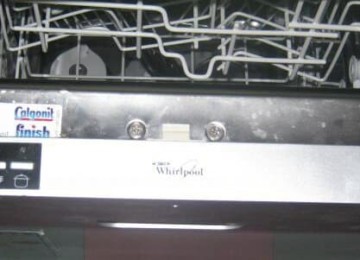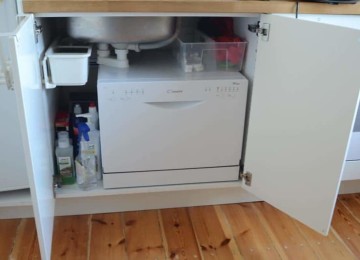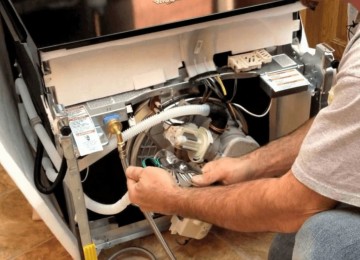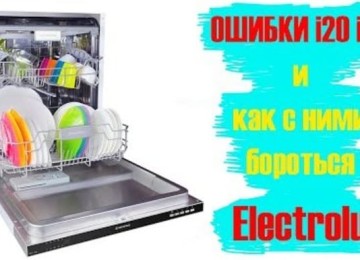 Dishwashing machines entered our lives relatively recently, but quickly gained popularity and continue to rapidly increase it. This is not surprising - a modern household appliance not only frees the housewife from routine and unpleasant work, but also removes dirt more efficiently. Manufacturers offer washing mashines with different dimensions and technical parameters. Of particular interest to consumers are narrow dishwashers, which most successfully combine functionality and ergonomics.
Dishwashing machines entered our lives relatively recently, but quickly gained popularity and continue to rapidly increase it. This is not surprising - a modern household appliance not only frees the housewife from routine and unpleasant work, but also removes dirt more efficiently. Manufacturers offer washing mashines with different dimensions and technical parameters. Of particular interest to consumers are narrow dishwashers, which most successfully combine functionality and ergonomics.
Advantages of dishwashers
High-tech dishwashing devices, regardless of model, size and manufacturer, have general positive properties that are attractive to consumers:
- The machine is easy to use. In order to start the washing process, you just need to load dirty dishes, select a mode and press the start button.
- The device uses water economically, which reduces costs and, over time, allows you to justify the cost of buying a machine over time.
- Dishes are washed in hot water, the temperature of which can reach 70°C. This allows you to better wash away dirt and destroy bacteria.
- Thanks to the water pressure factor, objects with a textured surface - graters, cutting boards, colanders - are ideally washed.
- Heavily soiled objects, frying pans, baking trays, duck dishes, are washed without damaging the surface that brushes would cause them manually.
- After finishing washing, the dishes do not need to be dried as the machine has a drying function.
Advantages of narrow dishwashers
The kitchen space cannot always boast of large dimensions - it is for such cases that small-sized devices are intended. It is quite justified to purchase narrow dishwashers in other situations:
- In small families or for lonely people.
- If the device you like fits perfectly into the style of the kitchen set.
Etcand in this case, narrow models fully fulfill their purpose without causing disappointment to owners. On the contrary, small-sized dishwashers have additional advantages:
- Lower cost.
- Reduced energy and water consumption.
- Shortened washing time.
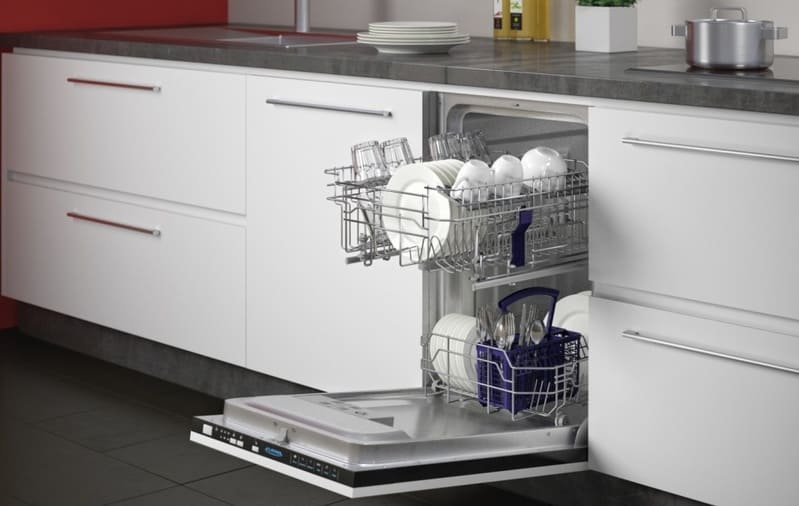
Disadvantages of a dishwasher
Assessing the undoubted advantages of narrow washing mashines, one cannot help but note their disadvantages. First of all, this modest capacity. For some consumers who pay a lot of attention to their cooking, the inability to wash large pots and baking trays can be an unpleasant surprise.
You also need to remember that before loading dishes into the machine, you need to clean off any remaining food from the plates, and carefully place all items prepared for washing inside the device, otherwise the quality of washing will suffer.
Users also need to be prepared for the fact that the machine may not be able to cope with too much carbon deposits, and the dirty item will have to be cleaned manually.
Types of dishwashers
According to the installation method, dishwashers can be divided into built-in And freestanding.
- Embedded devices are more attractive. They blend harmoniously with the interior, hiding behind the door facade. Fully built-in models are especially invisible - with a closed control panel. The disadvantages of this type of machine are its higher cost and the need to think about its purchase and placement in advance.
- Plus freestanding dishwasher is the ability to place it anywhere in the kitchen, provided it is convenient to connect to communications. Consumers will appreciate this option during a possible repair or replacement with a more modern model.
Owners of small kitchens are attracted by the option of installing a dishwasher under the sink. This is a truly ergonomic solution, but only a unit with certain parameters is suitable for it. The height of the device is of decisive importance, since it is necessary to take into account the depth of the sink and the size of the siphon. The height of the machine should be no more than 45 cm. There are no narrow and low models, so only a compact model with a width of 55 cm can be placed under the sink. Before installing it, it is recommended to replace the siphon with a flat analogue and secure the lower shelf.An additional disadvantage of such a placement of the machine is the limited access to communications in an emergency.
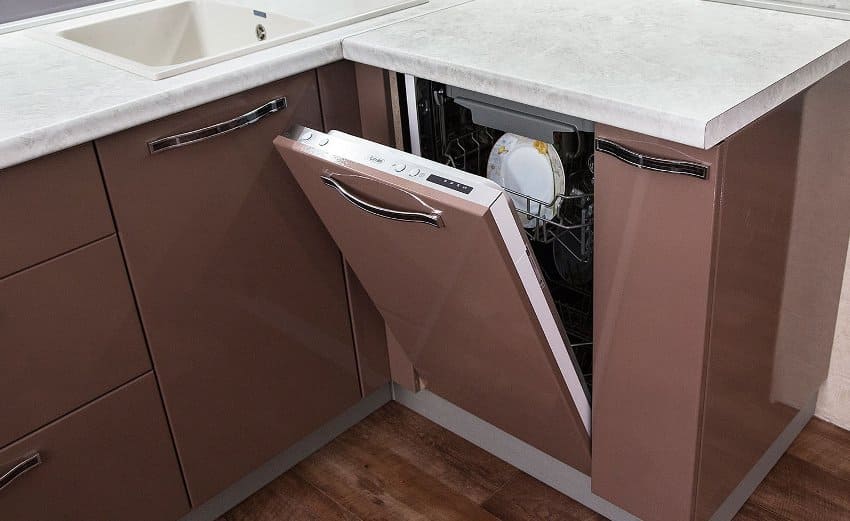
Classification of machines by size
All offered by manufacturers machines are divided into three types: narrow, compact, full-size. The concept of a narrow dishwasher implies not only its width, but also its capacity. The best option is a dishwasher with a width of 45 cm. Models of such dimensions are compact enough to be used in cramped conditions, and at the same time have good capacity. In very small kitchens of houses of the Soviet period - Khrushchev, Brezhnev, very narrow dishwashers with a width of 40 cm or even 35 cm will be relevant. They have a small capacity, and the owners of such appliances will have to wash the dishes in several steps.
An important parameter of a dishwasher is the number of sets of dishes that can be washed at one time. This concept means a set of dishes for one person, it includes three plates of different sizes, a pair of tea, a glass and cutlery consisting of two spoons, a knife and a fork. When choosing a unit, you need to know exactly how many dishes are expected to be washed during a normal lifestyle, not taking into account holidays and receptions. Cooking containers and kitchen utensils are not included in the kit - they are supposed to be washed separately.
Tips for choosing a dishwasher
When choosing a narrow model of a new home assistant, you should pay attention to the following parameters:
- Device width and loading chamber capacity. A standard narrow dishwasher with a width of 45 cm is designed to simultaneously load 8-12 sets. This capacity is quite sufficient for a small family.If you plan to regularly wash large pots and pans, then you need to choose a machine with a larger capacity.
- Cleaning class. This parameter determines the level of cleanliness of the dishes. All well-known brands produce class A equipment. Classes B and C imply the possibility of slight contamination after washing.
- Water consumption class. The most economical is class A with a consumption of 15 liters.
- Energy class. Class A is preferred.
- Type of drying. Drying can be conditioned, intensive, turbo.
- Modes work. Common and always in demand are standard, economical, intensive. The pre-soaking, delayed start and half-load functions are very popular among housewives.
- Control. There are two options - mechanical, which is considered more reliable, although outdated, and more convenient electronic.
- Connection method - simultaneously to hot and cold water supply, only to hot, only to cold.
- Noise level. This indicator is especially important for families with small children and elderly people as it affects the comfort of living.
- Safety. This parameter implies protection against leaks, grounding, circuit breaker, and door locking while the machine is operating.
When choosing a narrow dishwasher, you need to focus on the actual conditions of its use. Often tempting modes and additional functions remain unclaimed, and the machine does not justify the investment in it. It is much more rational to prefer a device with a small number of really necessary programs, but with a high level of protection and economical consumption of resources.
When purchasing complex household appliances, it is a good idea to choose a trusted manufacturer.The best models of narrow washing mashines are produced by well-known companies Bosch, Electrolux, Siemens, Zanussi. Hansa. The higher cost is fully compensated by the quality and reliability of the device. Many modern models are equipped with ergonomic baskets, convenient options, and are able to determine the degree of contamination and choose the optimal operating mode.






